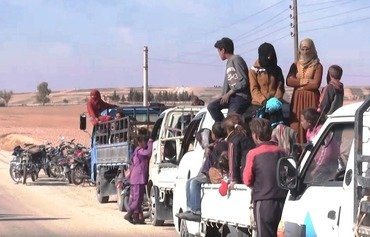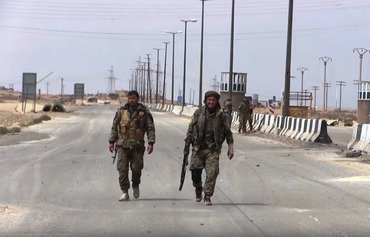The Syrian Democratic Forces (SDF) are taking new steps to enhance security in areas liberated from the "Islamic State of Iraq and Syria" (ISIS) and at crossings between these areas and the rest of northern Syria.
These measures are designed to ensnare ISIS elements who are passing through liberated areas as they head for cities such as Idlib or try to leave the country.
The SDF have been working to enhance security since the start of the al-Raqa offensive, said SDF officer Farhad Khoja, who took part in Operation Wrath of the Euphrates.
"Back then, all the crossings and roads were closely monitored, particularly when waves of civilians would flee and ISIS elements would shave their beards and hide among civilians to avoid capture," he told Diyaruna.
![A member of the Syrian Democratic Forces checks cars at a security checkpoint at one of the entrances to al-Raqa city. [Photo courtesy of the Syrian Democratic Forces]](/cnmi_di/images/2017/12/13/10664-syria-security-cr-600_384.jpg)
A member of the Syrian Democratic Forces checks cars at a security checkpoint at one of the entrances to al-Raqa city. [Photo courtesy of the Syrian Democratic Forces]
Many ISIS fighters were caught in this way as they attempted to escape, he said, adding that some were detained by the SDF, while others were handed over to the international coalition to face justice.
Other security measures included monitoring displacement camps on the outskirts of al-Raqa city, in the al-Raqa province town of Ain Issa, and on the periphery of the military operations in Deir Ezzor, he said.
Additionally, internally displaced persons (IDPs) in the camps have been required to verify their identity, he said, noting that civilians have been fully co-operating with this process.
Strict security measures
The SDF has been closely monitoring the borders of liberated areas, which is key to capturing rogue ISIS elements, said Adnan Azadi of the Asayesh (Kurdish internal security forces).
Security measures also have been tightened in and around al-Raqa, he told Diyaruna.
Meanwhile, the population of rural Deir Ezzor has been under close surveillance, he said, with security forces checking ID documents and recording the names of returnees and any other relevant information about them.
"Every returnee must obtain a security clearance from the relevant authorities before being allowed back in, and after that, they are given a document that allows them to move around freely in the liberated areas," he said.
People without such documents are subject to arrest.
The security apparatus charged with finding ISIS operatives is not limited to one area, he added, but extends from the liberated areas of al-Raqa to Ain Issa, Afrin and Kobani up to the border strip and rural Deir Ezzor.
This area is protected by unified security forces tasked with finding and capturing wanted ISIS elements, he said.
Foreign fighters fled before battle
"Investigations revealed that smugglers operating in the area have helped a large number of foreign fighters escape," he said, "and showed they have received thousands of dollars in return for taking ISIS elements to the border or to Idlib."
Some of the ISIS fighters attempting to flee threatened the smugglers with death and harm to their families if they did not co-operate, he added.
It is clear that many ISIS leaders and elements, including foreign fighters, managed to leave al-Raqa before the battle to liberate the city commenced, said Aleppo media activist Faisal al-Ahmed.
This would explain why some of them have resurfaced in other parts of Syria and in other countries, he told Diyaruna.
Several Syrian media activists have been tracking the escape of ISIS elements, tracing their journey via various media reports of their sighting or capture in other parts of Syria, such as Idlib, or in Europe.

![A number of 'Islamic State of Iraq and Syria' fighters are believed to have shaved their beards and hidden among the waves of al-Raqa residents who were fleeing the city ahead of the battle to liberate it from the group. [Photo courtesy of the Syrian Democratic Forces]](/cnmi_di/images/2017/12/13/10663-syrians-walk-cr-600_384.jpg)






